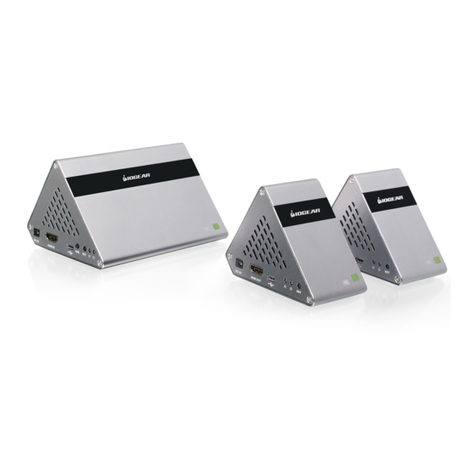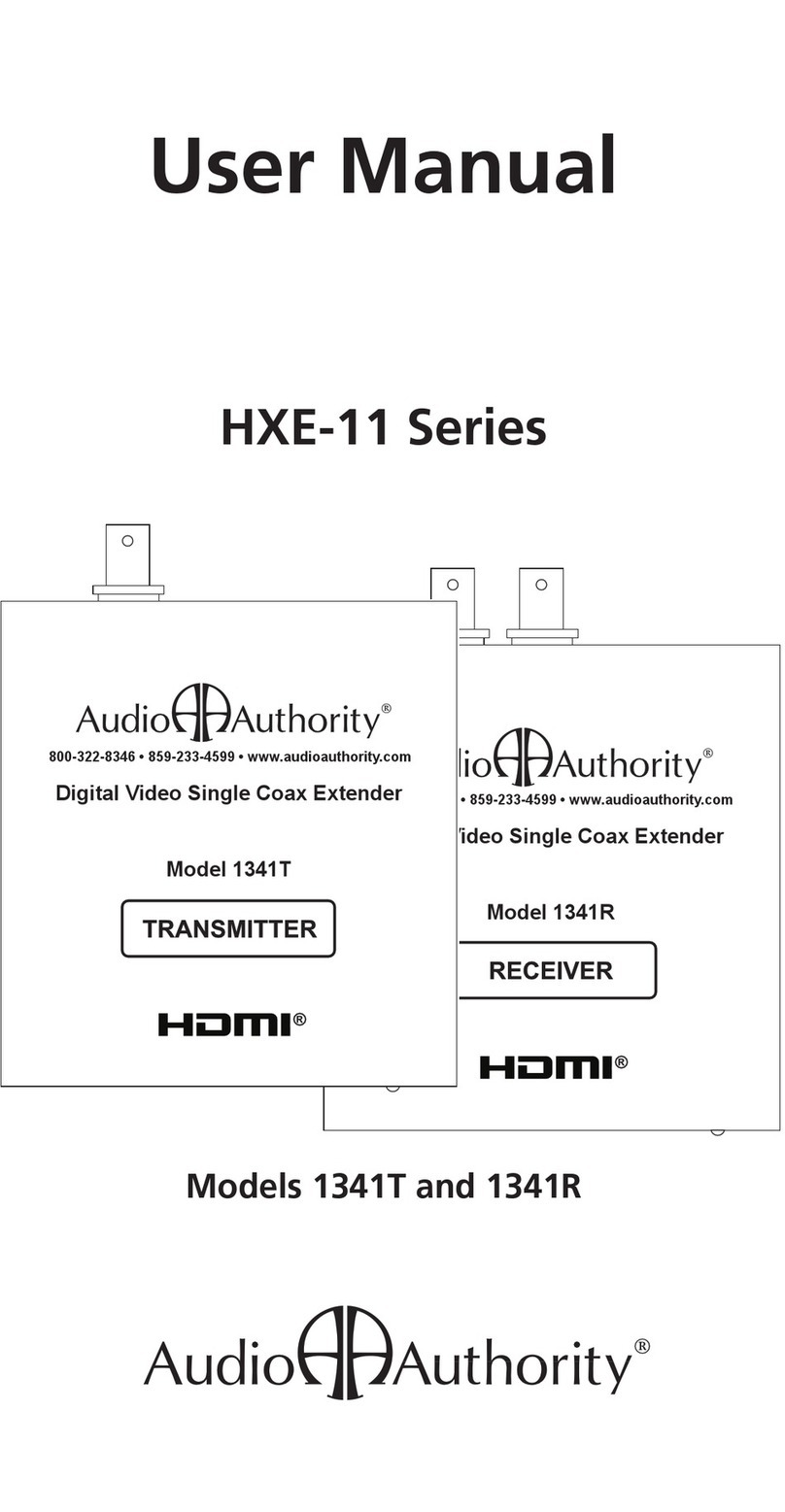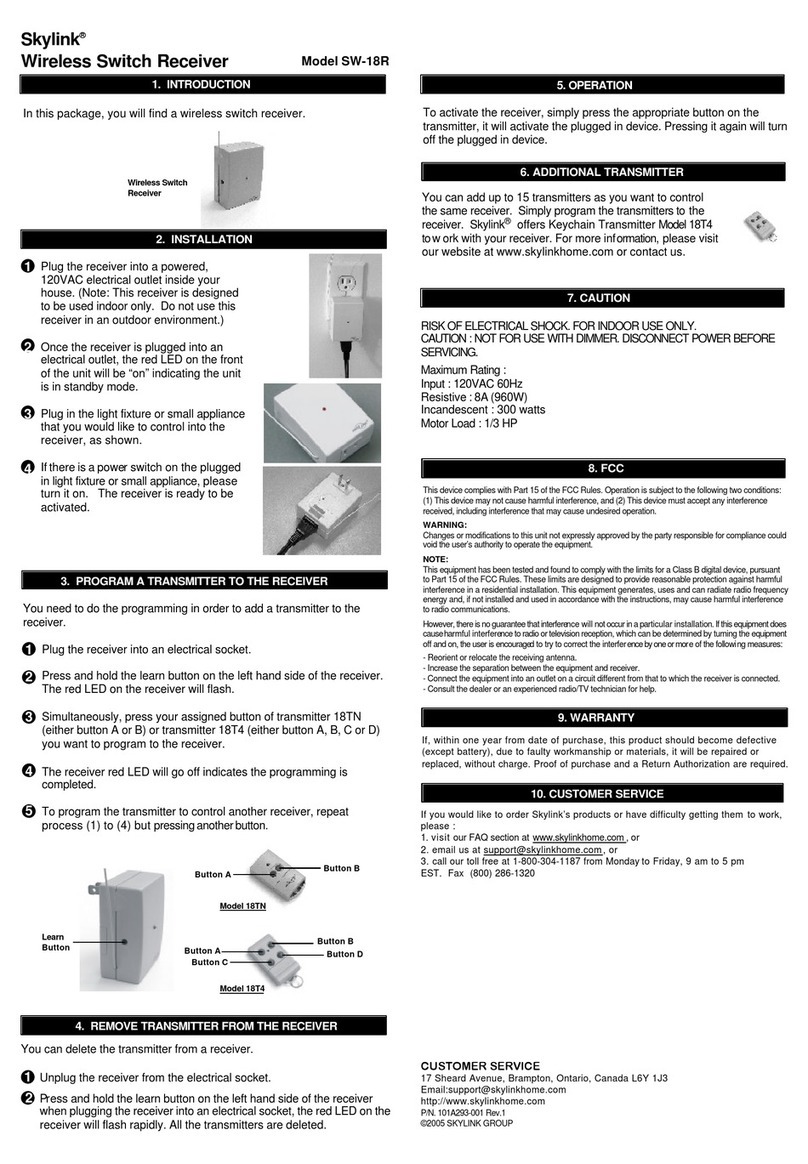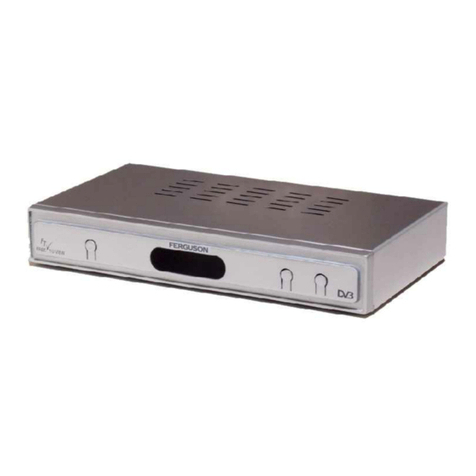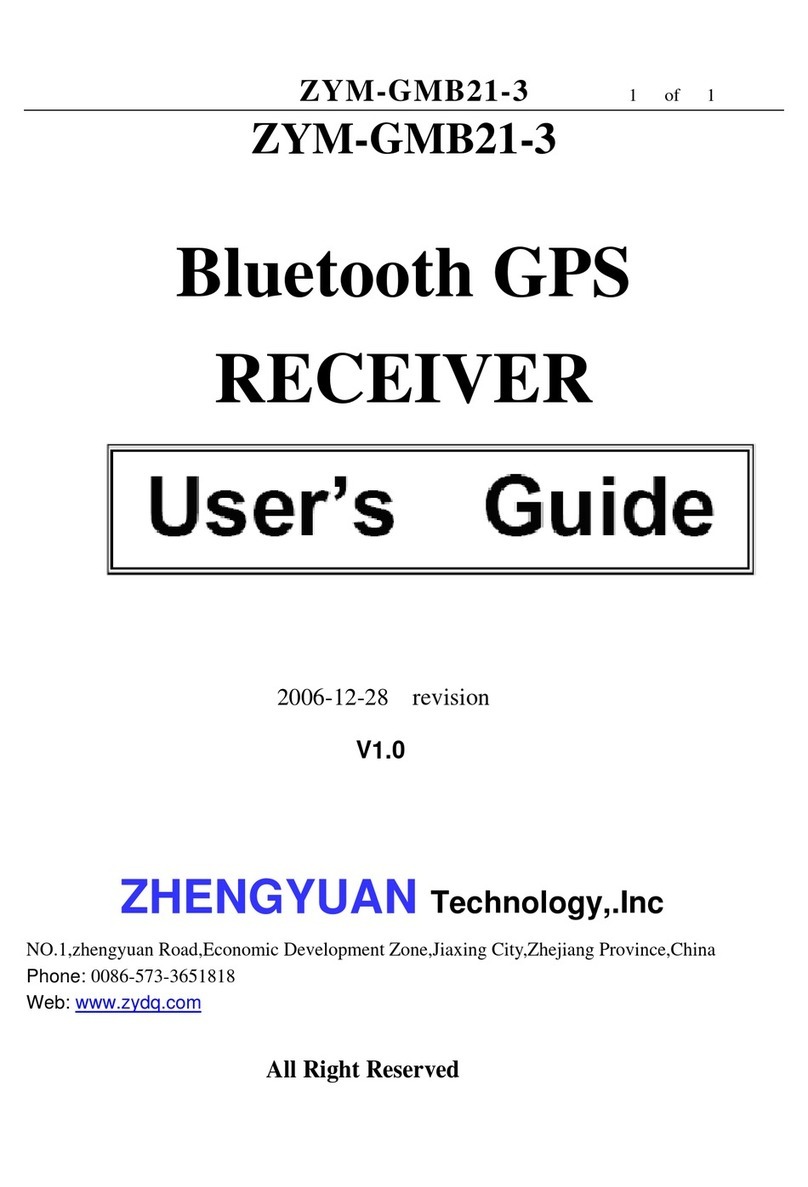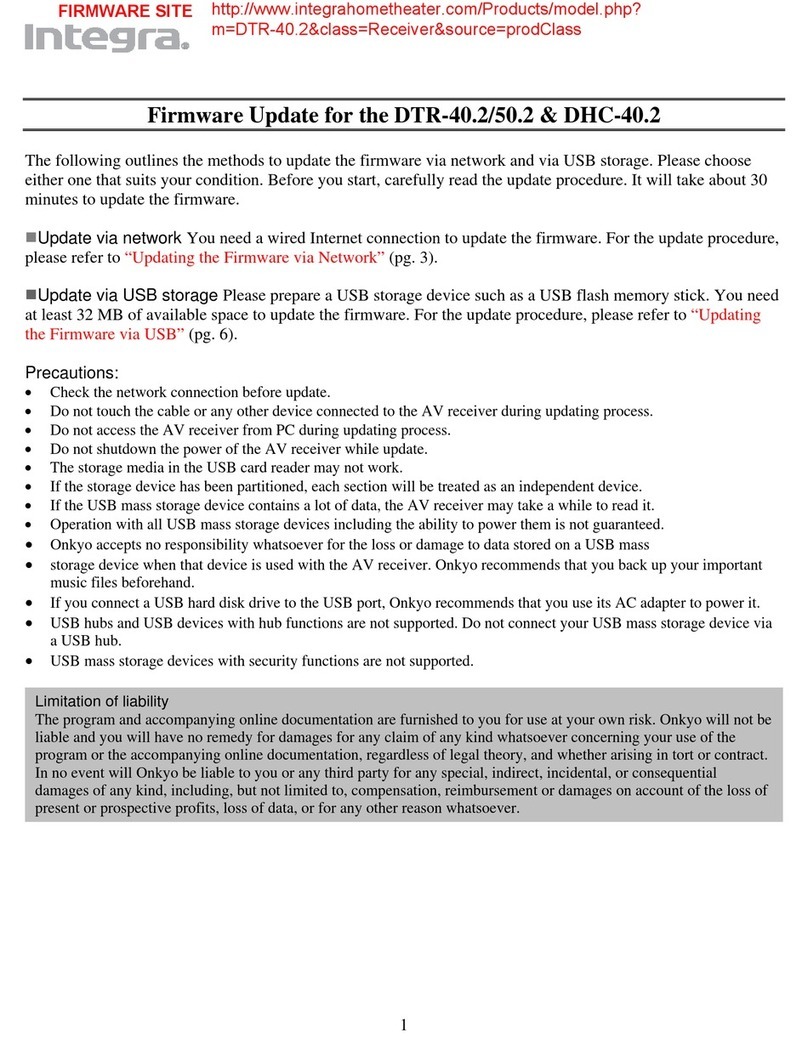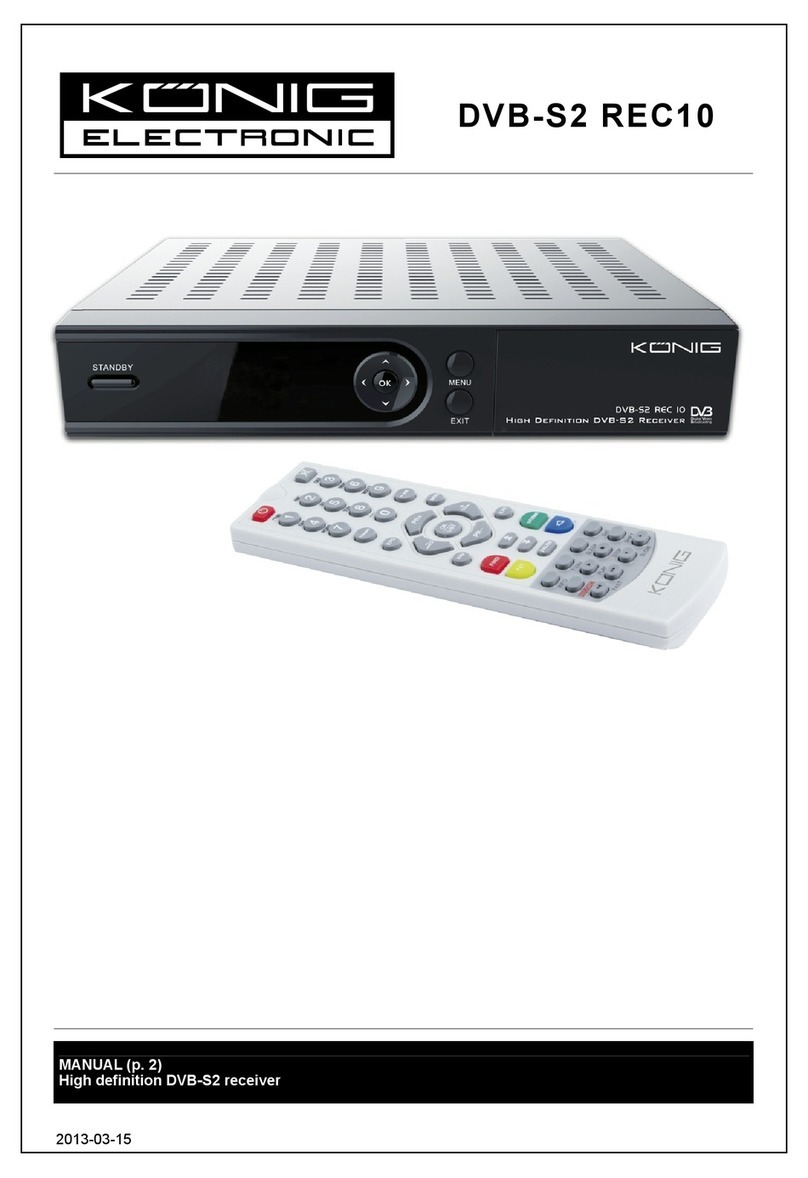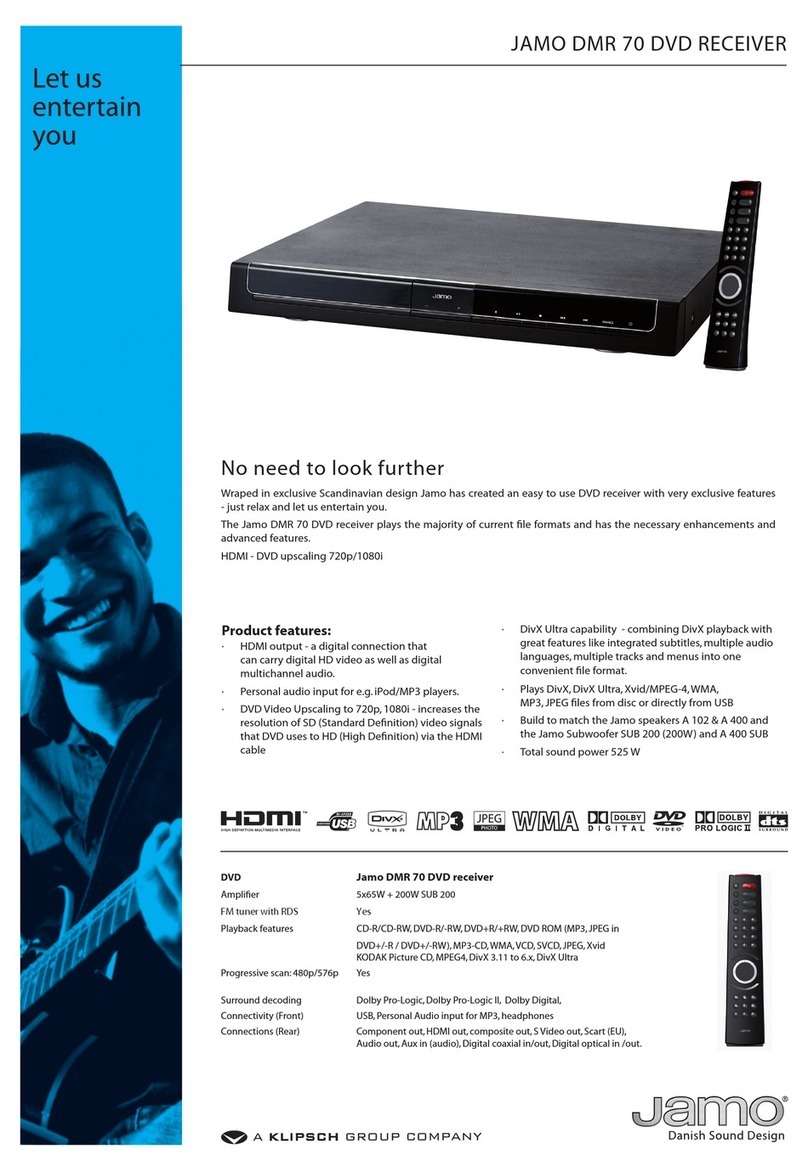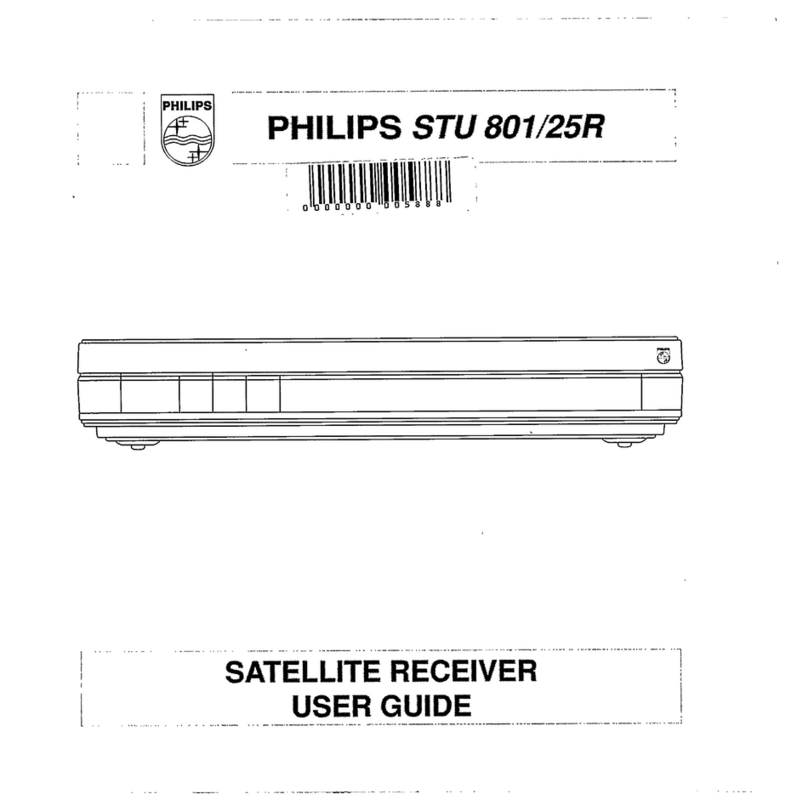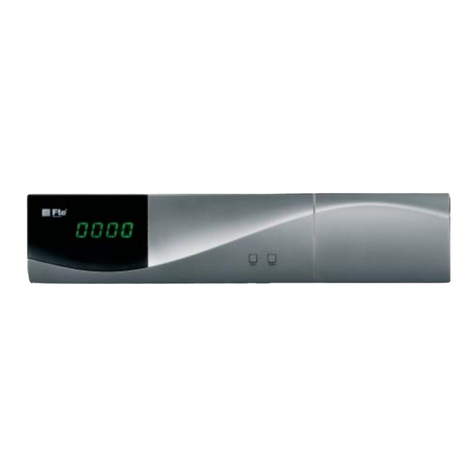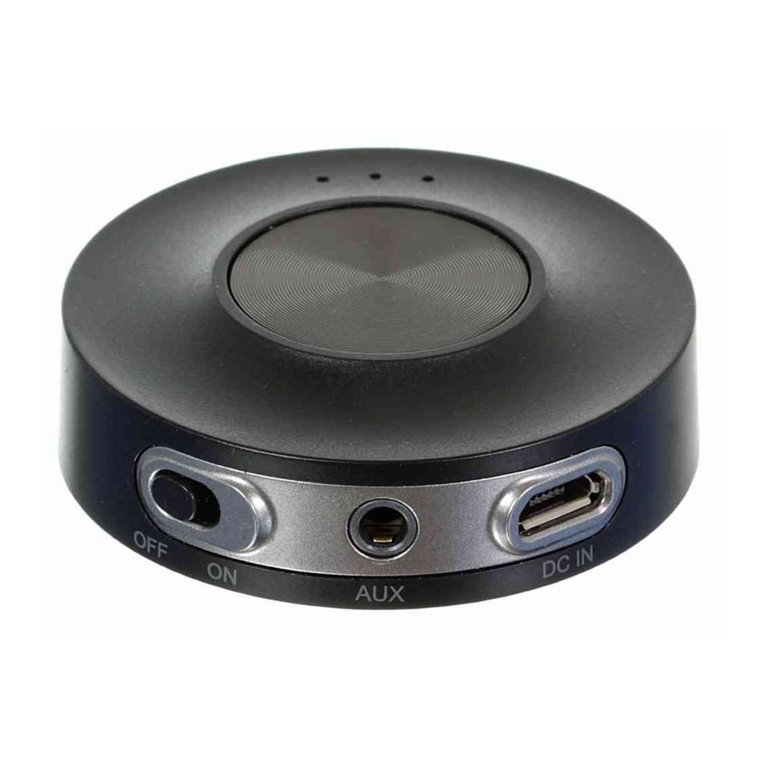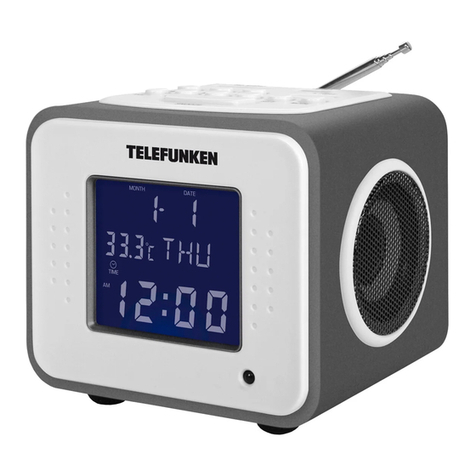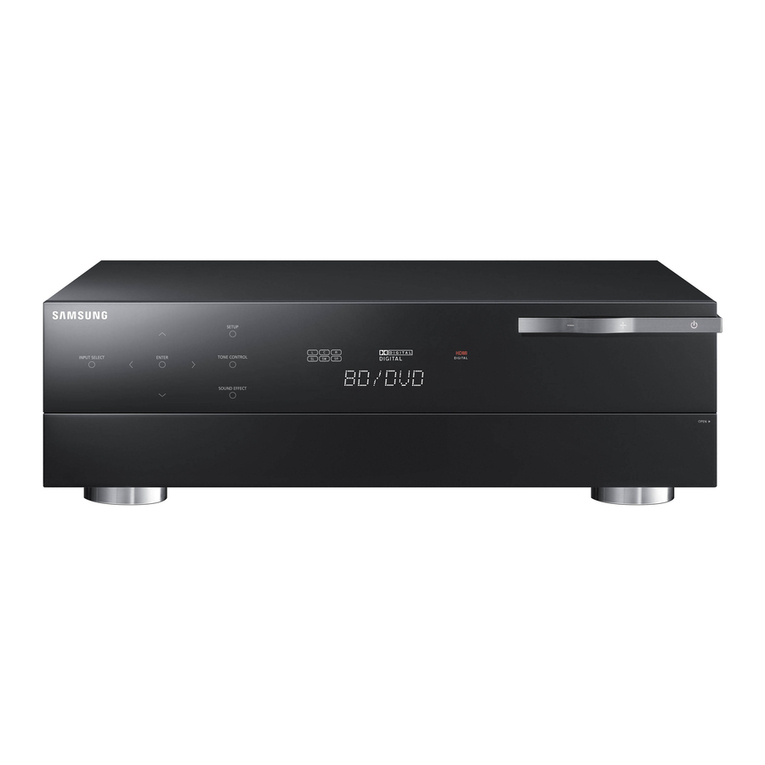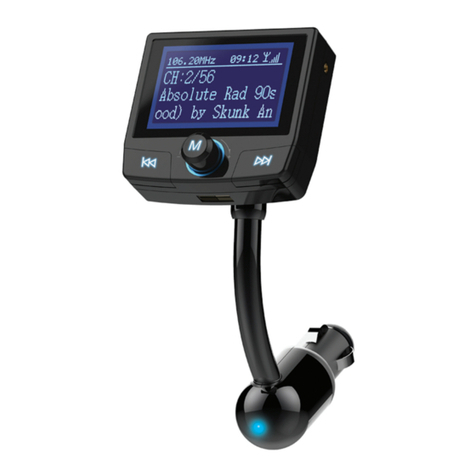TechComm TCR-1002 User manual

TCR-1002 RECEIVER
Rev. A – 6/4/2012
OPERATION MANUAL
TCR-1002 HF RECEIVER
500 kHz – 30 MHz
WITH RX-340 INTERFACE
This document and subject matter disclosed herein are proprietary items to which TechComm,
Inc. retains the exclusive right of dissemination, reproduction, manufacture, and sale.
This document is provided to the individual or using organization for their use alone, in the
direct support of the associated equipment unless permission for further disclosure is
expressly granted in writing.
All Right Reserved
Copyright © 2012 TechComm, Inc.
TechComm, Inc.
511 SE 32nd Court
Fort Lauderdale, FL 33316
www.TechCommDF.com
Telephone: 954-712-7777
FAX: 954-712-8880

TCR-1002 HF RECEIVER
Rev. A – 6/4/2012
2
STANDARD WARRANTY
TechComm, Inc. (herein after referred to as "TechComm") warrants this equipment to be free
from defects in material and workmanship, under normal use and service, when used for the
purpose for which designed, for a period of one year from the date of shipment, provided that
the notice of defect is received by TechComm within days after discovery thereof and provided
that inspection by TechComm indicates the equipment or parts are defective.
The obligations of TechComm, under this warranty, are limited to the repair or replacement of
the defective parts and the return of such repaired or replacement parts to the purchaser. At
TechComm's option, any defective part(s) shall be returned to TechComm, properly packed
and all expenses prepaid. No equipment or parts shall be returned unless the purchaser first
obtains prior approval from TechComm. Equipment furnished by TechComm, but
manufactured by others, bears only the warranty given by such other manufacturer, which will
be furnished upon request. Excluded from manufacturers warranty are, physical deterioration
of parts such as cables and protective coatings, caused by normal wear and tear usage, and
damage caused by catastrophic acts of nature, product abuse, inadequate maintenance, or
improper handling, hookup installation, operation, and repair.
No warranties, other than those expressly stated herein, are given or implied with respect to
the equipment furnished and TechComm shall, in no event, be liable for consequential
damage, or for loss, damage or expense, directly or indirectly, arising from the use of the
products, or any inability to use them, either separately or in combination with other equipment
or materials, or from any other cause.
This technical manual is applicable to the following units as listed below:
Model No. Serial No.
TCR-1002 HF Receiver ...................................................................................................... XXXX

TCR-1002 HF RECEIVER
Rev. A – 6/4/2012
3
TABLE OF CONTENTS
SECTION 1: UNPACKING, INSTALLATION, AND INTERFACE
1.0 Unpacking the TCR-1002 HF Receiver..............................................................................5
1.1 Installation and Inspection..................................................................................................5
SECTION 2: INTRODUCTION
2.0 Introduction ........................................................................................................................6
2.1 General Description ...........................................................................................................6
2.2 Use with Spectrum Enterprise............................................................................................6
2.3 Signal Path.........................................................................................................................6
SECTION 3: FRONT PANEL
3.0 Power Switch .....................................................................................................................7
3.1 Power On LED ...................................................................................................................7
3.2 Rotary Encoder ..................................................................................................................7
3.3 Keypad...............................................................................................................................8
3.4 Headphone Jack ................................................................................................................8
3.5 Headphone Volume Adjust Knob .......................................................................................8
3.6 Gain Adjust Knob ...............................................................................................................8
3.7 Speaker Volume Adjust Knob ............................................................................................8
3.8 Squelch Adjust Knob..........................................................................................................8
SECTION 4: DESCRIPTION OF TOUCHSCREEN KEYS AND FUNCTIONS
4.0 Frequency ..........................................................................................................................9
4.1 Bargraph ............................................................................................................................9
4.2 Signal (SIG) .......................................................................................................................9
4.3 Squelch (SQL) ...................................................................................................................9
4.4 Frequency Step (STEP) .....................................................................................................9
4.5 Automatic Gain Control Mode (AGC Mode) .....................................................................10
4.6 Bandwidth (BW) ...............................................................................................................10
4.7 Receiver Mode (MODE)...................................................................................................11
4.8 BFO..................................................................................................................................11
4.9 Automatic Gain Control Gain (AGC GAIN).......................................................................11
4.10 Attenuator/Amplifier (ATT/AMP).......................................................................................11
4.11 Noise................................................................................................................................11
4.12 Notch................................................................................................................................12
4.13 Option ..............................................................................................................................12

TCR-1002 HF RECEIVER
Rev. A – 6/4/2012
4
TABLE OF CONTENTS (CONTINUED)
SECTION 5: REAR PANEL
5.0 AC Power ........................................................................................................................13
5.1 Fuse Holder .....................................................................................................................13
5.2 Spare Fuse Holder...........................................................................................................13
5.3 RS-232 Control ................................................................................................................13
5.4 AUDIO/AUX .....................................................................................................................13
5.5 Antenna Input...................................................................................................................14
5.6 External Speaker .............................................................................................................14
5.7 Ground Lug ......................................................................................................................14
5.8 Spare ...............................................................................................................................14
SECTION 6: RS-232 INTERFACE
6.0 Serial Cable Definition .....................................................................................................15
6.1 Communications ..............................................................................................................15
SECTION 7: SPECIFICATIONS
7.0 Receiver Specifications ...................................................................................................21
7.1 Physical Characteristics ...................................................................................................21
FIGURES
1 Front Panel Layout.............................................................................................................7
2 Touchscreen Display..........................................................................................................9
3 Option Display....................................................................................................................9
4 Rear Panel Layout ...........................................................................................................13
TABLES
1 Serial Cable Definition......................................................................................................15

TCR-1002 HF RECEIVER
Rev. A – 6/4/2012
5
SECTION 1: UNPACKING, INSTALLATION, AND INSPECTION
1.0 UNPACKING THE TCR-1002 HF RECEIVER
Examine the shipping carton for damage before the equipment is unpacked. If the carton's
exterior appears to be damaged, retain all packing material and the shipping container for the
carrier's inspection. If damage to the equipment is evident after it has been unpacked, verify
that the equipment is complete as listed on the associated packing slip. Contact TechComm
for shortages or discrepancies.
1.1 INSTALLATION AND INSPECTION
The Standard TCR-1002 HF Receiver is shipped with:
1. TCR-1002 HF Receiver
2. Power Cord
3. Operation Manual

TCR-1002 HF RECEIVER
Rev. A – 6/4/2012
6
SECTION 2: INTRODUCTION
2.0 INTRODUCTION
The TCR1002 HF Receiver operates in the AM, FM, CW, LSB, and USB modes across the
500 kHz – 30 MHz frequency range. Demodulated audio is available at a front panel speaker.
An audio phone jack is also available for monitoring by a dedicated operator.
2.1 GENERAL DESCRIPTION
The TCR-1002 HF Receiver has state of the art DSP type architecture. This allows both high
performance and flexibility due to most of the parameters being defined in the program, not by
hardware. The RF chain contains minimal analog circuitry compared to traditional super
heterodyne configurations, and the entire range of the receiver is digitized early in the signal
path. There are no mixers or intermediate frequency (IF) conversion. A/D conversion
encompasses the entire 500 kHz to 30 MHz range simultaneously. This eliminates "birdies"
and images that are often found in super heterodyne receivers. The tuning, bandwidth,
detection, noise reduction and audio processing are all done digitally. See Figure 1.
2.2 USE WITH SPECTRUM ENTERPRISE*
This version of the TCR-10XX family is programmed to emulate the Ten-Tec RX-340**, in
regards to use of the serial communication port. The TCR-1002 does not use the full RX-340
command set. This configuration allows the TCR-1002 to be used with Spectrum Enterprise,
as configured for the RX-340.
* Spectrum Enterprise is a Trade Mark of Signal Intelligence Inc., San Jose, CA
**The RX-340 is manufactured by Ten-Tec, Sevierville, TN
2.3 SIGNAL PATH
The signal is brought in via a SO-239 (UHF) connector. The connector has a built-in lightning
arrestor with a replaceable gas cartridge. In the event of a strike, the cartridge will discharge
most of the energy to ground. The failure mode is short-to-ground, and the element can be
easily replaced without any special tools if this occurs.
The signal is then routed to the band-pass filter circuit. One of 8 filters is selected, depending
on the frequency. The filters are ½-octave (except the lowest, entirely in the AM BCB) to
ensure that harmonics are not introduced to the A/D converter. The filter ranges are:
500 kHz to 1.44 MHz 7.50 MHz to 10.40 MHz 1.44 MHz to 2.44 MHz
10.40 MHz to 14.30 MHz 2.44 MHz to 3.60 MHz 14.30 MHz to 20.24 MHz
3.6 MHz to 7.5 MHz 20.24 MHz to 30.00 MHz
The filters are followed by a pre-amplifier and attenuator that can be manually turned on or off
or left on AUTO for management by the AGC circuit. AUTO is the recommended setting for
most situations.

TCR-1002 HF RECEIVER
Rev. A – 6/4/2012
7
SECTION 3: FRONT PANEL
The front panel consists of the Touchscreen Display (see Section 4, Figure 2), Power Switch,
Encoder, the Keypad, Phones Jack and Volume Adjust Knob, Gain Adjust Knob, Squelch
Adjust Knob, Speaker and Volume Adjust Knob.
FIGURE 1
FRONT PANEL LAYOUT
3.0 POWER SWITCH
The receiver is powered "ON" by pushing the top of the rocker switch
3.1 POWER ON LED
The power "ON" is confirmed when the LED is lit.
3.2 ROTARY ENCODER
The rotary encoder is a multipurpose input device.
The default mode is for FREQUENCY change. The encoder will change the frequency in steps
defined in the STEP window at a rate of 16 per revolution.
If one of the 12 windows on the touchscreen is selected, the encoder can be used to scroll
through the available values.
In most cases, the UP and DOWN buttons can be used as an alternative to scrolling with the
encoder. The new value will be selected when another window is selected. The window in use
will automatically save and revert to the FREQUENCY function after 10 seconds of inactivity.

TCR-1002 HF RECEIVER
Rev. A – 6/4/2012
8
3.3 KEYPAD
The numeric keypad is used for direct entry of frequency. The FREQUENCY box on the
display needs to be selected (this is the default state) before entry can be made. Any valid
frequency can be entered, independent of step size. The frequency can be in MHz of kHz,
depending on which mode has been selected for the FREQUENCY display.
3.4 HEADPHONE JACK
The Headphone output is independent of the speaker audio circuit. Headphones should have a
standard ¼" plug. The output is mono. If stereo-wired phones are used, the audio will appear
on one side only.
3.5 HEADPHONE VOLUME ADJUST KNOB
This controls the volume of the headphone jack only.
3.6 GAIN ADJUST KNOB
This control can be used to reduce RF maximum gain. The normal setting is fully clockwise,
allowing the AGC circuit to use the full range, as required. The user can manually reduce the
gain by turning the control counter-clockwise. This setting will be represented in the GAIN
window on the touchscreen.
3.7 SPEAKER VOLUME ADJUST KNOB
This controls the speaker volume. When the Ext. Speaker is plugged into the real panel, the
level is set by this control and the front panel speaker is cut off.
3.8 SQUELCH ADJUST KNOB
The SQUELCH level is indicated in the upper right-hand area of the touchscreen. When the
SIG level exceeds the SQL level, the sound will be unmuted.

TCR-1002 HF RECEIVER
Rev. A – 6/4/2012
9
SECTION 4: DESCRIPTION OF TOUCHSCREEN KEYS AND FUNCTIONS
All of the receiver information and user selectable
parameters are accessed on the combination
display screen and touch panel. The approach
used on the display is to show current settings on
the 12 amber boxes arrayed in a 3 X 4 pattern.
The values can be changed by selecting a box by
touch and then changing the value from a
predetermined set by rotating the encoder or
using the UP or DOWN key on the keypad. See
Figure 2.
4.0 FREQUENCY
The FREQUENCY box is the default for the
touchscreen. Frequency can be changed by the
rotary encoder, UP/DOWN buttons on the keypad, or by direct numeric entry on the keypad.
When using the encoder or UP/DOWN buttons, the frequency will change in increments
determined by the currently selected STEP.
4.1 BAR GRAPH
The bar graph gives a visual indication of relative signal strength in a 10 bar representation, as
measured at the A/D converter. There are 6 green, 3 yellow and 1 red segments. If the red is
illuminated, the signal will overload the receiver. This should rarely occur if the AGC circuit is
left in full control. If the red LED is on, check to see that the ATT/AMP is in the AUTO setting.
4.2 SIG
This number is in dB and represents the signal level at the antenna input. For this reason, the
number will not change significantly if the ATT/AMP setting is changed, or the GAIN is
manually changed.
4.3 SQL
This number represents the squelch threshold in dB, referenced to the level at the antenna
input. Whenever the SIG level exceeds the SQL level, the audio will be unmuted.
4.4 STEP
The step size is selected by rotating the encoder or using the UP or DOWN keys on the
keypad. The current setting will be saved on power-down.
FIGURE 2
TOUCHSCREEN DISPLAY

TCR-1002 HF RECEIVER
Rev. A – 6/4/2012
10
The available steps are:
1Hz 2Hz 5Hz 10Hz 20Hz 50Hz
100 Hz 200 Hz 500 Hz 1 kHz 2 kHz 5 kHz
10 kHz 20 kHz 50 kHz 100 kHz
4.5 AGC MODE
There are 3 predefined AGC settings and 3 user settings.
The available selections are:
FAST MEDIUM SLOW USER 1 USER 2 USER 3
Attack Time is the rate at which the RF gain decreases when a signal increases and the AGC
has the gain set too high. The Attack Time is set in dB/ms.
Decay Time is the rate at which the AGC circuit increases the RF gain when a signal
decreases in level. Decay Time is in dB/sec.
Hang Time is the time period where the AGC circuit maintains gain at the same level after a
decrease in signal has occurred. Hang Time is in seconds, with 0.1 second steps.
Decay time is usually much slower than attack time. The combination of these variables allows
the user to select a setting where the gain does not "pump" at a syllabic rate, especially when
in SSB or CW Modes. The user settings can accommodate values of attack and decay chosen
by the user.
4.6 BW
There are 48 user selectable bandwidths available, limited by mode in some cases. The
bandwidth is obtained by a combination of RF and audio DSP filters. The 7 different RF
bandwidths are selected automatically to be compatible with the audio frequency selected on
the display. The bandwidth is selected by the encoder or the UP and DOWN buttons. The
current setting will be saved on power-down for the mode the receiver is currently in. AM, FM,
CW and SSB (USB or LSB). USB and LSB bandwidths are not stored separately.
AM Bandwidths
600 Hz 800 Hz 1.0 kHz 1.2 kHz 1.4 kHz 1.6 kHz 1.8 kHz 2.0 kHz 2.2 kHz
2.4 kHz 2.8 kHz 3.0 kHz 3.2 kHz 3.6 kHz 4.0 kHz 5.0 kHz 6.0 kHz 7.0 kHz
8.0 kHz 9.0 kHz 10 kHz
USB/LSB/CW Bandwidths
600 Hz 800 Hz 1.0 kHz 1.2 kHz 1.4 kHz 1.6 kHz 1.8 kHz 2.0 kHz 2.2 kHz
2.4 kHz 2.6 kHz 2.8 kHz 3.0 kHz 3.5 kHz 4.0 kHz

TCR-1002 HF RECEIVER
Rev. A – 6/4/2012
11
FM Bandwidths
600 Hz 800 Hz 1.0 kHz 1.2 kHz 1.4 kHz 1.6 kHz 1.8 kHz 2.0 kHz 2.2 kHz
2.4 kHz 2.6 kHz 2.8 kHz 3.0 kHz 3.5 kHz 4.0 kHz 4.5 kHz 5.0 kHz 6.0 kHz
8.0 kHz 10 kHz 12 kHz 14 kHz 16 kHz
4.7 MODE
There are five detector modes to select from. The current mode will be saved on power-down.
The available modes are:
AM FM CW LSB USB
4.8 BFO
The BFO function allows the pitch of a CW signal to be varied without changing the tuned
frequency. The pitch can be changed in 10 Hz increments to a value between 0 and 2000 Hz
using the rotary encoder or the UP/DOWN buttons on the keypad. Direct entry to 1 Hz may
also be entered on the numeric keypad. BFO is not available in any other modes.
4.9 AGC GAIN
The number in this window is the maximum gain, limited by the GAIN control. When fully
clockwise, full gain is available for management by the AGC circuit. Turning the control
counter-clockwise reduces the maximum gain, when the user desires manual control of this
function.
4.10 ATT/AMP
The default setting is AUTO. This allows the AGC management circuit to optimize the S/N ratio
by actively managing the front end of the receiver. The ATT/AMP function allows the operator
the flexibility to manually override the AGC and set the attenuator or preamp. The current
setting will be saved on power-down.
The available settings are:
AUTO ATT PREAMP OFF
4.11 NOISE
The DSP noise reduction circuit will reduce wideband hiss and automatically notch interfering
carriers when the circuit is enabled. There are 8 levels of noise reduction available. The
highest reduction levels may introduce audio distortion, hollow sound or other DSP artifacts, so
some adjustment may be needed as signal conditions vary with time. Moderate levels are less
likely to cause these effects. The current setting will be saved on power-down.
The available noise reduction levels are:
OFF 9Db 11dB 13dB 15dB 17dB 20dB 24dB 35dB

TCR-1002 HF RECEIVER
Rev. A – 6/4/2012
12
4.12 NOTCH
The NOTCH function is enabled when NOISE is selected. The circuit is automatic and will null
1 or 2 tones without the need for manual adjustment. The depth of the null can be increased by
selecting a greater degree of noise reduction with the NOISE function. The null depth is
indicated in the NOTCH window.
The levels available are:
OFF 4dB 5dB 6dB 8dB 16d B 21dB 25dB 65dB
4.13 OPTION
When OPTION is selected, numerous
parameters are available. The first row is for
setting up the serial port baud rate, parity, data
bits and stop bits. The second row is for
configuring the receiver for multidrop operation.
The bottom row is used for setting the screen
saver time-out, backlight level and keypad lock-
out. As on the main screen, the selected box can
be changed with the encoder or the UP/DOWN
buttons. See Figure 3.
FIGURE 3
OPTION DISPLAY

TCR-1002 HF RECEIVER
Rev. A – 6/4/2012
13
SECTION 5: REAR PANEL
The rear panel consists of AC Power Socket, Fuse Holder, Spare Fuse Holder, RS-232
Control Connector, Audio/Auxiliary Connector, Antenna Connector, External Speaker Jack,
and a Ground Lug. See Figure 4.
FIGURE 4
REAR PANEL LAYOUT
5.0 AC POWER
The receiver is wired to accept 115 Volts AC, 50/60 Hz. Consult the factory for instructions if
the requirement is different. The proper line cord is furnished with the TCR-1002 HF Receiver.
5.1 FUSE HOLDER
The fuse should be a 2 Amp fast-blow type. To remove fuse, push in and rotate counter-
clockwise. Reverse the procedure to install a new fuse.
5.2 SPARE FUSE HOLDER
A spare 2 amp fast-blow fuse is stored in this holder.
5.3 RS-232 CONTROL
This is a standard RS-232 configuration. See OPTION (Section 6, on page 15 - ) for
communication setup.
5.4 AUDIO/AUX
Single-ended DC-coupled audio is available on pin #10 and AC-coupled audio on pin #2. The
level is about 2.0 Vpp. Pins #1 and #9 are grounded.

TCR-1002 HF RECEIVER
Rev. A – 6/4/2012
14
5.5 ANTENNA INPUT
The connector is 50 ohm unbalance and accepts a male UHF type (PL-259) coaxial connector.
An integral lightning arrestor is included in this part and the gas tube is replaceable in the
event of a strike.
5.6 EXT SPEAKER
This accepts a ¼" standard phone plug. When used, the front speaker is disconnected and the
level is controlled by the speaker VOLUME control on the front panel.
5.7 GROUND LUG
The #10-24 lug is used for bonding the receiver chassis to an earth ground. This should be a
low-impedance connection using a large conductor with as short a length as is practical. The
ground conductor is normally a #8 or larger flat braid. Note that this conductor may be a path
of least resistance in the event of a lightning strike to the antenna or AC power lines. Check
with local codes for compliance.
5.8 SPARE
Reserved for options.

TCR-1002 HF RECEIVER
Rev. A – 6/4/2012
15
SECTION 6: RS-232 INTERFACE
This section describes the RS-232 serial interface. The serial interface is accessed through the
RS-232 (DB-25) connector. The serial interface data format is asynchronous, full-duplex, with
selectable communications parameters. These parameters include the baud rate, parity, the
number of data bits, and stop bits. Support for a Multidrop RS-232 Network is controlled by
enabling the multidrop option, selecting an address and a settable transmit delay time, if
necessary.
6.0 SERIAL CABLE DEFINITION
The serial interface acts as a DCE device and a three wire interface is required for bidirectional
communications.
TABLE 1
SERIAL CABLE DEFINITION
Pin Signal Description
2 TXD Transmit Data (from host to Radio)
3 RXD Receive Data (from Radio to host)
7 GND Signal Ground
6.1 COMMUNICATIONS
Establishing communications with the TCR1002 HF Receiver requires selecting the device
first. This is accomplished by sending a $nnn command. This command must include the
receiver's address. Commands may be sent independently or stacked together; regardless, it
must be terminated with a carriage return.
Command Range Description
Annn 0 – 120 dB Manual AGC Attenuation
Sets the maximum allowed Gain of the AGC. Zero
corresponds to the maximum gain level.
Command Range Description
B±n.nnn ±2.0 kHz BFO Frequency
Sets BFO offset frequency when the receiver is in CW
mode.
Command Range Description
Dn 1, 2, 3, 6, 7 Detector Mode
This command allows setting the receiver detection mode.
1: AM, 2: FM, 3: CW, 6: LSB, 7: USB

TCR-1002 HF RECEIVER
Rev. A – 6/4/2012
16
Command Range Description
Fnn.nnnnnn 0.5 – 30 MHz Frequency
Allows setting the operating Frequency with a resolution of
1 Hz from 0.5 – 30 MHz. Least significant digits may be
dropped. Display frequency is the suppressed carrier
frequency in sideband modes and passband center in all
other modes.
Command Range Description
Hnnn 0 – 250 ms Set RS-232 Delay
Controls the time between tx-output enable and the
occurrence of the first transmitted bit on the RS-232
transmit line. This command may be used to overcome an
RS-232 controller with a slow response. Units are in
milliseconds.
Command Range Description
Inn.nn 0.6 – 20 kHz Bandwidth
This command selects the IF-filter Bandwidth. Bandwidth
range varies depending on the detector mode. If an
operator requests an unavailable filter, the receiver will
select the closest wider filter to the request. Units are in
kHz.
Command Range Description
Kn 1 – 4 Attenuator
A
llows selection of the amp / attenuator mode. Auto mode
allows the receiver to automatically select the best
operating state.
1: Amp off / Attenuator off
2: Amp on / Attenuator off
3: Amp off / Attenuator on
4: Auto mode
Command Range Description
Mn 1 – 6 AGC Operating Mode
Selects the AGC operating mode. Where 'n' is one of the
following:
1: Fast, 2: Medium, 3: Slow, 4: User 1, 5: User 2, 6: User 3

TCR-1002 HF RECEIVER
Rev. A – 6/4/2012
17
Command Range Description
MAnn.nn 0.01 – 2 dB/ms AGC Attack Rate
Set AGC user mode Attack Rate in dB/ms.
Command Range Description
MDnnn 1 – 1000 dB/s AGC Decay Rate
Set AGC user mode Decay Rate in dB/s.
Command Range Description
MHnn.n 0.1 – 10 secs AGC Hang Time
Set AGC user mode Hang time in seconds.
Command Range Description
#— Dump AGC State and Restart AGC Process
Command Range Description
TM Query the Programmed AGC Settings
Command Range Description
On 0 – 9 Noise Reducer and Auto Notch Filter. Range is from 0 (off)
to 9.
Command Range Description
P±n.nnn ±2.0 kHz Passband Tuning
A
llows setting Passband Tuning. This feature is available in
CW and SSB modes, and shifts the filter's center frequency
without affecting the receiver's operating frequency or BFO.
Command Range Description
Qnnn 0 – 150 Squelch Threshold
A
llows setting Squelch control. Entry of 0 represents
Minimum threshold (open squelch) and 150 represents
maximum threshold. This corresponds to (-140 to +10
dBm).

TCR-1002 HF RECEIVER
Rev. A – 6/4/2012
18
Command Range Description
Un 1, 4, 5 DSP Interface Control
This Interface is permanently disabled (U1). U4 and U5
commands are accepted.
4: Multidrop Mode On
5: Multidrop Mode Off
Command Range Description
Z— Master Reset
This command forces all receiver parameters back to
factory default conditions except for the communication
parameters (baud, parity, data, stop, multidrop, address,
delay). The receiver resets to local mode.
Command Range Description
Wnnn 0 – 199 Write Memory Parameters
Write current Operating Parameters to memory number
'nnn'. The memory channel holds all basic receiver
operating parameters.
Command Range Description
Rnnn 0 – 199 Read Memory Parameters
Replaces the receiver's current operating parameters with
the parameters stored in channel 'nnn'.
Command Range Description
G— Report Status
Receiver responds with all operating parameters relevant to
the current operating mode. Parameters that are OFF, or
are not relevant to the current mode, will not be included in
the response.
Command Range Description
Tx(xxx) — Report Specific Status
The receiver responds with the operating data, as specified,
prefaced by the command.

TCR-1002 HF RECEIVER
Rev. A – 6/4/2012
19
Command Range Description
X0 – 150 Report Signal Level
This command responds with the current S-meter level.
This corresponds to (-140 to +10 dBm).
Command Range Description
V — Report Firmware Version Number
Command Range Description
J — Report All Operating Parameters
The receiver responds with all operating parameters
regardless of their current use or relation to the current
operating modes.
THE FOLLOWING ASTERISK COMMANDS ARE SUPPORTED
Command Range Description
*CX — Stop Scanning and Return to Manual Mode
Ignored if scan isn't active.
Command Range Description
*TSbsss 0 – 255 Request Scan Status
'b' is a single decimal number containing bit-encoded status
information:
Bit 0: Set if Scan is in Dwell-Time cycle.
Bit 1: Set if Dwell is set to infinite (Dwell time set to zero).
Bit 2: Set if Squelch is open (channel is active).
Bit 3: Set if running MScan. Cleared if running PScan.
Bit 4: Set if Scan (MScan or PScan) is active. Cleared
otherwise.
Bit 5: Set if Scan is in Dead-Time cycle.
Bit 6: Set if Scan is in Gaze-Time cycle.
Bit 7: Set if Scan is in Pause state.
Command Range Description
*Rn 0, 1 Select Remote mode
0: Set Local Mode.
1: Set Remote Mode.

TCR-1002 HF RECEIVER
Rev. A – 6/4/2012
20
THE FOLLOWING ASTERISK COMMANDS ARE NOT SUPPORTED
Program scan functions: *C0, *C1, *C2, *CA, *CB, *CD, *CN
Memory scan functions: *C4, *C5, *CS, *CU, *CE
Common scan functions: *C3, *C6, *C7, *C8
Scan control functions: *CP, *CG, *CF, *CM
Scanning query functions: *TA, *TM, *TD, *TR, *TC, *TL, *TF, *CK, *TI
Security functions: *L1, *L0, *S1, *S0
THE FOLLOWING RECEIVER COMMANDS ARE NOT SUPPORTED
E- Audio / IF Select
N- Notch Frequency
! - User Output Control
Table of contents
